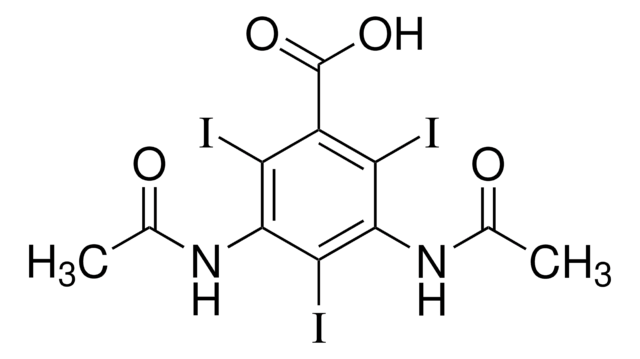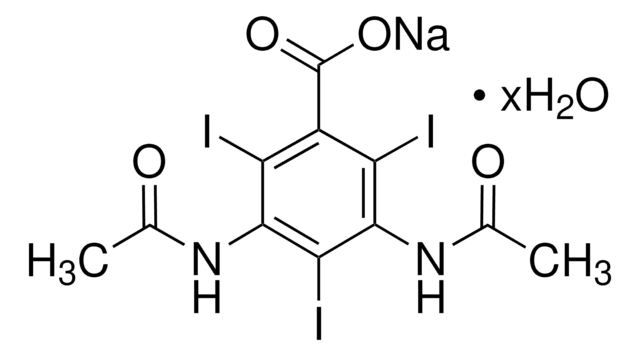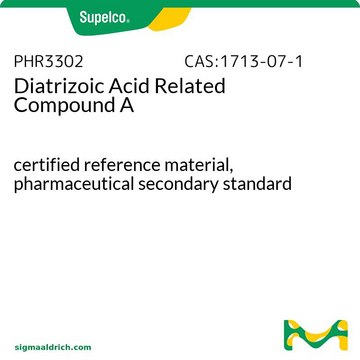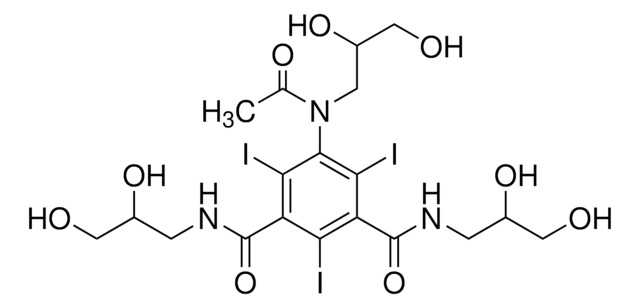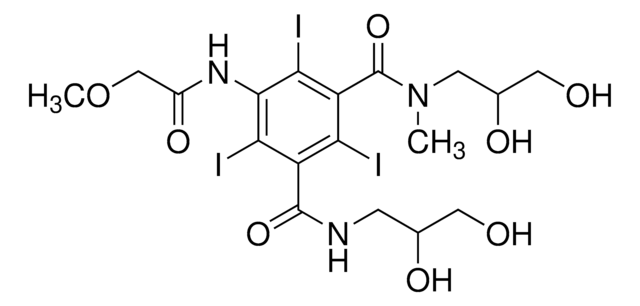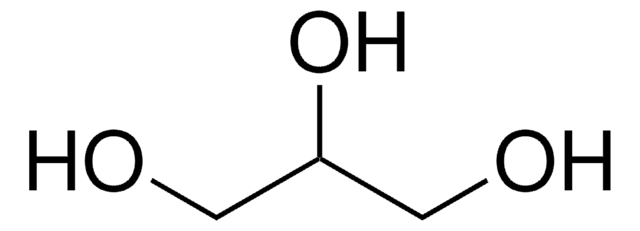1184005
USP
Diatrizoic acid
United States Pharmacopeia (USP) Reference Standard
Synonym(s):
Diatrizoic acid dihydrate, 3,5-Bis(acetylamino)-2,4,6-triiodobenzoic acid dihydrate, Amidotrizoic acid dihydrate
About This Item
Recommended Products
grade
pharmaceutical primary standard
API family
diatrizoic acid
manufacturer/tradename
USP
application(s)
pharmaceutical (small molecule)
format
neat
SMILES string
CC(=O)Nc1c(I)c(NC(C)=O)c(I)c(C(O)=O)c1I
InChI
1S/C11H9I3N2O4/c1-3(17)15-9-6(12)5(11(19)20)7(13)10(8(9)14)16-4(2)18/h1-2H3,(H,15,17)(H,16,18)(H,19,20)
InChI key
YVPYQUNUQOZFHG-UHFFFAOYSA-N
Looking for similar products? Visit Product Comparison Guide
1 of 4
This Item | 49779 | 15523M | 104057 |
|---|---|---|---|
| Quality Level 200 | Quality Level 200 | Quality Level 100 | Quality Level 300 |
| grade ACS reagent, puriss. p.a. | grade - | grade - | grade ACS reagent |
| assay ≥99.5% (GC) | assay - | assay 99.0-101.0% (alkalimetric), 99.0-101.0% (calc. on H2O free substance) | assay ≥99.5% (GC), 98.0-101.0% (calculated on anhydrous substance, alkalimetric) |
| form viscous liquid | form liquid | form liquid | form liquid |
| cation traces Ca: ≤5 mg/kg, Co: ≤1 mg/kg, Cu: ≤1 mg/kg, K: ≤20 mg/kg, Mn: ≤1 mg/kg, Na: ≤20 mg/kg, Pb: ≤1 mg/kg, Cd: ≤1 mg/kg, Fe: ≤1 mg/kg, NH4+: ≤5 mg/kg, Zn: ≤1 mg/kg, Cr: ≤1 mg/kg, Ni: ≤1 mg/kg, Mg: ≤1 mg/kg | cation traces - | cation traces As: ≤1 ppm, Cu: ≤0.001%, Pb: ≤1 ppm, Zn: ≤0.001% | cation traces Al: ≤0.00005%, B: ≤0.000002%, Ba: ≤0.00001%, Ca: ≤0.0001%, Cd: ≤0.000005%, Co: ≤0.000005%, Cr: ≤0.000002%, Cu: ≤0.000005%, Fe: ≤0.00001%, Mg: ≤0.0001%, Mn: ≤0.00001%, Ni: ≤0.000002%, Pb: ≤0.00001%, Sn: ≤0.00001%, Zn: ≤0.00001%, heavy metals (as Pb): ≤0.00020% |
General description
For further information and support please go to the website of the issuing Pharmacopoeia.
Application
- Diatrizoate Meglumine
- Diatrizoate Meglumine and Diatrizoate Sodium Injection
- Diatrizoate Meglumine and Diatrizoate Sodium Solution
- Diatrizoate Meglumine Injection
- Diatrizoate Sodium
- Diatrizoate Sodium Injection
- Diatrizoate Sodium Solution
Analysis Note
Other Notes
related product
Storage Class Code
11 - Combustible Solids
WGK
WGK 3
Flash Point(F)
Not applicable
Flash Point(C)
Not applicable
Choose from one of the most recent versions:
Certificates of Analysis (COA)
It looks like we've run into a problem, but you can still download Certificates of Analysis from our Documents section.
If you need assistance, please contact Customer Support.
Already Own This Product?
Find documentation for the products that you have recently purchased in the Document Library.
Articles
Centrifugation enables the separation of particles by sedimentation. Learn how to separate particles using a centrifuge and how to use Stokes' law to calculate the velocity of sedimentation.
Our team of scientists has experience in all areas of research including Life Science, Material Science, Chemical Synthesis, Chromatography, Analytical and many others.
Contact Technical Service